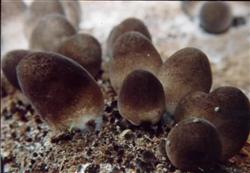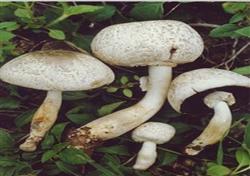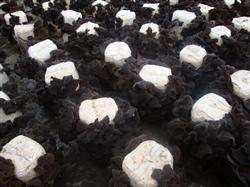Control measures for abnormal growth of volvariella volvacea

Straw mushroom is a kind of grass saprophytic fungus which likes temperature and humidity. it is easy to master cultivation techniques and low production cost, so it is one of the fastest-earning edible fungi. However, after sowing, some abnormal phenomena often appear in the growth process of volvariella volvacea, which affect not only the yield but also the quality. In this paper, the causes and preventive measures of abnormal phenomena in the growth of volvariella volvacea are introduced as follows, which can be used as a reference for straw mushroom growers. The main results are as follows: 1. in general, the seed mass of volvariella volvacea begins to germinate about 12 hours after sowing, and continues to grow into the material. If the mycelium still does not germinate or does not grow into the material 24 hours after sowing, the mycelium may have shrunk. The cause of mycelial atrophy is ① high temperature burning bacteria. When the temperature in the culture medium exceeded 45 ℃ for a long time, the hyphae shrunk and died. The effect of ② drugs. Straw mushroom is very sensitive to pesticides. After sowing, some mushroom farmers will spray pesticides in order to prevent diseases and pests, resulting in mycelium atrophy due to drug damage. ③ was asphyxiated due to hypoxia. The water content of the culture material is too high (more than 70%) or the plastic film is too strict, which causes the mycelium of volvariella volvacea to shrink due to hypoxia. ④ ammonia hazard. If the urea in the culture material is added too much or the content of chemical fertilizer in the field is too high, the volatile ammonia can not be emitted, which is harmful to the mycelium of volvariella volvacea. The strain of ⑤ is inferior. The age of the strain is too short or too long, the vitality is weak, the stress resistance is poor, and it shrinks under unsuitable environmental conditions. The temperature difference of ⑥ is too large. The mycelium of volvariella volvacea is sensitive to temperature difference, such as the temperature is above 32 ℃ in daytime and below 28 ℃ at night, the mycelium will shrink after spraying water. Insect pests occurred in ⑦. Pests appeared in the culture material, and the hyphae shrunk due to the bite of the pests. Prevention of mycelial atrophy the growth cycle of volvariella volvacea is short. when mycelial atrophy is found, we should find out the cause in time, take effective measures, and replant new species in order to reduce unnecessary loss. The specific measures are: ① to prevent the temperature from getting too high. When growing in the open sun, it is best to build a simple sunshade to prevent the hyphae from burning out at high temperature at noon. In the process of composting the culture material, when the material temperature reached about 75 ℃, the pile was turned twice. The thickness of the paving material when entering the bed depends on the season, and it should be thicker when cultivated in the greenhouse in early spring and late autumn. ② does not use pesticides. The prevention and control of diseases and insect pests should be done when dealing with the raw materials, and the pesticide can no longer be applied to the material surface after sowing. ③ moisture should be appropriate. When sowing, the water content of the culture material is about 62%, with 1 or 2 drops of water seeping out of the fingers. In the case of high moisture and air temperature of the culture material, the film covered on the material surface should be propped up to facilitate ventilation. ④ prevents ammonia damage. The addition of urea should not exceed 0.2% and should be added at the time of stacking. High quality bacteria were selected for ⑤. The strain of volvariella volvacea was 15-20 days old, the hyphae distributed evenly, grew vigorously and neatly, the hyphae were gray and shiny, with reddish-brown chlamydospores, no miscellaneous bacteria and no insect mites. Strains that are more than 1 month old are not suitable for use. ⑥ uses water according to temperature. The water transfer of the culture material should be flexibly controlled according to the air temperature at that time, and the water temperature of spraying water should be basically consistent with the air temperature. ⑦ should do a good job in environmental hygiene and pay attention to insect control. The cultivation site should be far away from the livestock and poultry enclosure, the materials should be clean and mildew-free, and the sun should be exposed for 2 or 3 days before use. The mushroom house was thoroughly disinfected to put an end to the source of insects. Second, the mycelium grows excessively in the germ stage, when a large number of white villous aerial hyphae appear on the material surface. After the mycelium grew, it could not be transferred to reproductive growth in time, the budding was delayed, the mature mushroom was less, and the yield was low. The excessive growth of hyphae is mainly due to poor ventilation, resulting in high temperature, high humidity and high concentration of carbon dioxide in the bed, which stimulates the excessive growth of hyphae. The prevention material surface of mycelium is covered with plastic film. 2-3 days later, according to the growth of mycelium, the film is opened regularly during the day to properly ventilate, cool and wet, so as to promote the growth of straw mushroom mycelium.
- Prev

Control measures of straw mushroom dead mushroom
Volvariella volvacea is a kind of fungus with high temperature and constant temperature, which has strict requirements on the environment. According to the biological characteristics of volvariella volvacea and the author's experience in seed production and cultivation of volvariella volvacea for many years, the causes and countermeasures of the death of volvariella volvacea were discussed for readers' reference. First, the cause of the death of straw mushroom 1. The ventilation and moisturizing of the mushroom room are not coordinated. Grass.
- Next

How to cultivate auricularia auricula
First, an overview of black fungus, also known as fungus, light fungus, cloud ear. Classified into basidiomycetes, Tremella, Auriculaceae, Auricularia. There are more than ten species in this genus, such as Auricularia auricula. Auricularia auricula, horny fungus, shield-shaped fungus and so on. Only Auricularia auricula is rich and tender in texture and delicious in taste.
Related
- Fuxing push coffee new agricultural production and marketing class: lack of small-scale processing plants
- Jujube rice field leisure farm deep ploughing Yilan for five years to create a space for organic food and play
- Nongyu Farm-A trial of organic papaya for brave women with advanced technology
- Four points for attention in the prevention and control of diseases and insect pests of edible fungi
- How to add nutrient solution to Edible Fungi
- Is there any good way to control edible fungus mites?
- Open Inoculation Technology of Edible Fungi
- Is there any clever way to use fertilizer for edible fungus in winter?
- What agents are used to kill the pathogens of edible fungi in the mushroom shed?
- Rapid drying of Edible Fungi

